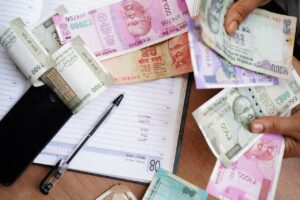Best First Account for Newborn: Sukanya PPF RD or NPS Vatsalya – Which is Right
Choosing the right savings account for your newborn is more than money – it’s the first step towards securing their future.
So it will be important to know about Sukanya PPF RD or NPS Vatsalya – Which is Right ?,Pros and Cons of Sukanya PPF RD & NPS Vatsalya, SIP Calculator and Sukanya vs PPF vs RD vs NPS.

Sukanya PPF RD or NPS Vatsalya – The Right Choice for Your Newborn
For new parents, one of the earliest and most crucial financial decisions is choosing the first savings or investment account for their newborn child. With rising costs of education, healthcare, and future needs, making the right decision at the start can significantly impact long-term financial security. In 2025, four popular options stand out: Sukanya Samriddhi Yojana (SSY), Public Provident Fund (PPF), Recurring Deposit (RD), and the newly introduced NPS Vatsalya.
This article provides a clear framework with a decision tree, apples-to-apples comparison, SIP projections, pros and cons, and practical insights so that parents can make a confident choice.
Why Choosing the Right Account Matters, i.e. Sukanya PPF RD or NPS Vatsalya – Which is Right
- Education Costs: By 2040, higher education expenses could be 3–5x today’s levels. Starting early ensures compounding works in your favor.
- Safety vs Growth: Parents must balance safe returns (like SSY/PPF) with growth potential (like NPS).
- Liquidity vs Lock-in: Newborn investments often need a mix of long-term lock-in (for discipline) and short-term liquidity (for emergencies).
- Tax Benefits: Tax savings under Section 80C and tax-free maturity are major decision drivers.
The best newborn investment account in 2025 is the one that balances safety, tax benefits, and long-term growth.
Decision Tree for Sukanya vs PPF vs RD vs NPS
Here’s a simple roadmap to help parents choose:
- Is your child a girl (0–10 years)? → Sukanya Samriddhi Yojana (highest safe return + tax-free)
- Do you need high liquidity? → Recurring Deposit (short tenure, taxable)
- Do you want safe + long-term + tax benefit? → PPF (15 years, EEE benefit)
- Do you want to build a large long-term corpus (education/retirement)? → NPS Vatsalya (market-linked 8–10%)
Sukanya, PPF, RD, and NPS Vatsalya are the top newborn saving schemes in 2025 – but most parents miss NPS Vatsalya in the comparison.
(Tip: Many families choose a combination, e.g., Sukanya for safety + NPS for growth.)
Detailed Comparison of Sukanya PPF RD & NPS Vatsalya
| Feature | Sukanya Samriddhi (SSY) | PPF | RD (Bank/Post) | NPS Vatsalya |
|---|---|---|---|---|
| Eligibility | Only girl child (0–10y) | Any individual | Anyone | Parents for newborn child |
| Rate (2025) | 7.6% p.a. | 7.1% p.a. | 5.5–7.5% (taxable) | 8–10% (market-linked) |
| Lock-in | Till girl’s 21 years | 15 years | 1–10 years | Till child’s 18 years |
| Tax Benefit | 80C + tax-free maturity | 80C + tax-free | 80C (5yr+), maturity taxable | 80C + tax-deferred, annuity taxable |
| Liquidity | Partial after 18 yrs | Partial after 7y | Flexible | Partial after 5 yrs |
| Best For | Girl child’s future | Long-term secure | Short-term savings | Education + retirement corpus |
Newborn savings in India: Sukanya for girls, PPF for security, RD for liquidity, and NPS Vatsalya for high growth.
SIP Calculator and Sukanya vs PPF vs RD vs NPS
To illustrate real-world outcomes, let’s compare monthly SIP investments across these schemes. Assumptions: Sukanya 7.6%, PPF 7.1%, RD 6.5% (taxable), NPS Vatsalya 9% (market-linked).
| Monthly SIP | Sukanya (15 yrs) | PPF (15 yrs) | RD (10 yrs) | NPS Vatsalya (15 yrs) |
|---|---|---|---|---|
| ₹1,000 | ₹3.7 lakh | ₹3.5 lakh | ₹1.65 lakh | ₹4.1 lakh |
| ₹2,000 | ₹7.5 lakh | ₹7.2 lakh | ₹3.3 lakh | ₹8.5 lakh |
| ₹5,000 | ₹18.8 lakh | ₹18.0 lakh | ₹8.25 lakh | ₹21.3 lakh |
A ₹2,000 SIP in Sukanya, PPF, or NPS Vatsalya can grow into lakhs by 2040 – starting early makes all the difference.”
(Figures approximate for illustration; NPS returns are market-linked and not guaranteed.)
Pros and Cons of Sukanya PPF RD & NPS Vatsalya
| Scheme | Pros | Cons |
|---|---|---|
| Sukanya | Highest safe rate, tax-free, for girl child | Only for girl child, long lock-in |
| PPF | Safe, tax-free, long-term corpus | 15-year lock-in, limited liquidity |
| RD | Flexible, short-term, disciplined saving | Taxable, lower return |
| NPS Vatsalya | High potential return, corpus building, tax benefit | Market risk, annuity taxable |
Sukanya and PPF offer safe, tax-free maturity; NPS Vatsalya gives higher growth but with market risk.
Deeper Insights for Parents
- Sukanya vs PPF: If you have a girl child, Sukanya beats PPF due to a slightly higher rate and tax-free maturity. But if you want flexibility or have a boy child, PPF is more suitable.
- RD vs Long-term Accounts: RD is useful for short-term goals (vaccinations, small milestones) but should not be the core newborn investment.
- NPS Vatsalya – The Hidden Advantage: It allows compounding for 15–18 years, regulated by PFRDA, and is perfect for education or retirement corpus creation.
Case Study Example
Let’s assume you invest ₹2,000 per month for 15 years:
- Sukanya Samriddhi (7.6%) → ~₹7.5 lakh, tax-free
- PPF (7.1%) → ~₹7.2 lakh, tax-free
- RD (6.5%, taxable) → ~₹3.3 lakh, taxable
- NPS Vatsalya (9% market-linked) → ~₹8.5 lakh (not guaranteed)
Even after tax adjustments, Sukanya and PPF are safe winners, while NPS can beat them in growth potential.
For a girl child, Sukanya Samriddhi is unmatched; for a boy, PPF or NPS Vatsalya is the smarter choice in 2025.
Future Outlook (2025+)
- Govt schemes like Sukanya & PPF will remain attractive as safe, tax-free instruments.
- RD will continue to serve short-term liquidity needs but won’t be a wealth builder.
- NPS Vatsalya is expected to gain popularity as more parents look for long-term, market-linked solutions.
NPS Vatsalya is expected to emerge as a leading child investment option alongside Sukanya and PPF.
Conclusion
If you have a girl child, Sukanya Samriddhi is the safest and most rewarding. If you want a gender-neutral, safe, long-term option, choose PPF. If you need short-term flexibility, RD is the answer. But for future-proofing your child’s higher education or retirement needs, NPS Vatsalya is a rare but powerful choice that parents should not ignore.
The best first account for a newborn in 2025 depends on the goal: Sukanya/PPF for safety, NPS Vatsalya for future-proof growth.
Useful Links
Can I open Sukanya for a boy child?
No, only for girl child under 10 years.
Which scheme gives tax-free maturity?

Sukanya & PPF.
Is NPS Vatsalya safe for newborn investment?

Returns are market-linked, but regulated by PFRDA. Good for long-term corpus.
Which scheme allows highest flexibility?
RD
Best choice for higher education fund?
NPS Vatsalya (if boy child) or Sukanya (if girl child)
Can I invest in more than one scheme?
Yes, many parents split across Sukanya/PPF (safety) and NPS (growth).
Sources
- Govt. notifications on small savings rates (Q1 2025)
- RBI / Post Office RD rate circulars
- PFRDA NPS Vatsalya scheme note (2024 launch details)












